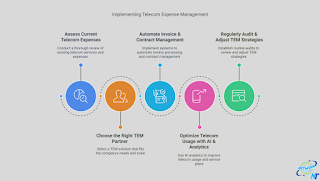Telecom Expense Management (TEM): Proven Strategies to Optimize Expenses and Enhance Business Performance
Telecom Expense Management (TEM): A Comprehensive Guide to Reducing Costs, Strengthening Security, and Enhancing Operational Efficiency
In today’s hyper-connected business environment, telecommunications are the backbone of companies of all sizes from lean startups to global enterprises. However, as organizations scale their voice, data, and cloud services across diverse geographies, they often encounter rising expenses and administrative complexity.
Telecom Expense Management (TEM) is a proven strategic discipline that enables companies to take control of these challenges by proactively tracking, auditing, and optimizing their telecommunications spending. By leveraging TEM best practices, companies can drive substantial savings, minimize security and compliance risks, and improve service quality across all regions whether operating in North America, Europe, the Middle East, or Asia-Pacific.
What is Telecom Expense Management (TEM)?
Telecom Expense Management (TEM) is a holistic, end-to-end process for tracking, auditing, and optimizing all telecom-related assets and services. Core elements typically covered by TEM include:
-
✅ Fixed-line and Mobile Communications
-
✅ Data and Broadband Circuits
-
✅ Internet of Things (IoT) Devices
-
✅ Cloud Communications (SaaS, UCaaS)
-
✅ Unified Communications and VoIP Services
By consolidating these services into a single TEM platform, organizations gain a transparent, real-time view of their total telecommunications spend. TEM eliminates manual invoice processing, pinpoints errors, identifies optimization opportunities, and provides actionable insights for strategic cost savings.
Why TEM is a Strategic Business Imperative
As the telecommunications landscape becomes more complex with emerging service offerings, device proliferation, and global deployments companies that lack a formal TEM program often face significant challenges:
-
❌ Excessive Spending due to under-utilized assets and overprovisioned services
-
❌ Billing Errors and misaligned contract terms resulting in recurring losses
-
❌ Poor Financial Visibility into all telecom expenses across business units and geographies
-
❌ Compliance Risks, including non-compliance with local telecom regulations and increased cybersecurity vulnerabilities
Implementing a disciplined TEM strategy helps mitigate these risks and empowers organizations to optimize telecom spend proactively. According to research by the Association of Telecom, Mobility & IT Management Professionals (AOTMP), companies deploying TEM achieve 10% – 30% savings annually through more accurate audits, contract optimization, and resource rationalization.
Core TEM Functions and Technical Pillars
A successful TEM implementation is built on five core functional areas, supported by robust technology and automated workflows:
1. Invoice Auditing & Payment Processing
-
Automated invoice validation against rates, terms, and usage
-
Identification of duplicate or unauthorized charges
-
Error detection rates up to 95% for rapid dispute resolution
2. Inventory & Asset Management
-
Centralized device and service tracking (mobile phones, data circuits, hardware)
-
Support for integration protocols like API and SNMP for real-time asset visibility
-
Optimized asset allocation and decommissioning of unused services
3. Usage Monitoring & Optimization
-
Analysis of consumption patterns to eliminate under-utilized or over-provisioned assets
-
Predictive analytics powered by AI and ML to align usage with demand
-
Service right-sizing to reduce costs without impacting performance
4. Order & Change Management (MACD)
-
Simplified Moves, Adds, Changes, and Deletes across all geographies
-
Automated workflows to minimize manual errors and deployment delays
-
Improved employee productivity with faster order fulfillment
5. Reporting & Analytics
-
KPIs such as cost per user, savings rates, and contract compliance rates
-
Powerful business intelligence tools for actionable, data-driven decision-making
-
AI-powered recommendations for continuous optimization
Benefits of Implementing Telecom Expense Management (TEM)
Implementing a Telecom Expense Management (TEM) program offers a range of strategic and operational benefits, including:
-
Cost Optimization: Enhances financial efficiency by reducing total telecommunications expenditures and improving cash flow.
-
Strengthened Financial Governance: Provides granular, real-time visibility into all telecommunications outlays, facilitating more accurate budgeting, forecasting, and expenditure control.
-
Cybersecurity and Compliance Assurance: Enables early identification of anomalous usage patterns, mitigating the risks of fraud, unauthorized access, and regulatory breaches.
-
Scalability of Operations: Deploys automated processes that scale seamlessly with business growth, allowing IT teams to dedicate more capacity to strategic innovation.
-
Contract and Vendor Optimization: Proactively monitors vendor agreements and renewal dates, ensuring competitive rates and preventing costly contract oversights.
Implementing TEM: Recommended Best Practices
Successful deployment of a TEM program requires a structured, methodical approach. Industry best practices suggest the following sequential steps:
-
Assess Current Expenses: Conduct a comprehensive baseline audit of all telecommunications invoices, contracts, assets, and services to establish a transparent cost and usage profile.
-
Define Clear Objectives and KPIs: Develop measurable performance targets (e.g., a 10–15% annual reduction in telecom expenses) to establish a framework for continuous performance evaluation.
-
Leverage TEM Tools and Platforms: Implement a TEM solution that integrates seamlessly with existing IT and business systems (e.g., ERP, ITSM, HR), providing a unified interface for streamlined management and reporting.
-
Promote Cross-Functional Collaboration: Foster ongoing cooperation among Finance, IT, Procurement, and other key departments to support process transparency, accountability, and continuous improvement.
-
Monitor, Review, and Optimize: Conduct periodic audits and benchmarking against KPIs to identify further cost savings and maintain long-term optimization of telecom assets and services.
Emerging Trends and Future Directions in TEM
As telecommunications continue to evolve, the scope of TEM is expanding to address the challenges and opportunities introduced by new technologies:
-
5G and 6G Networks: The deployment of ultra-fast, low-latency networks will drive increased complexity in service management and require new TEM capabilities.
-
Artificial Intelligence and Machine Learning: The integration of AI/ML tools will enhance predictive analytics, improve real-time anomaly detection, and streamline expense allocation processes.
-
Internet of Things (IoT) Expansion: The rapid proliferation of connected devices will demand precise provisioning, monitoring, and cost control to prevent overspending and inefficiency.
-
Blockchain and Smart Contracts: Distributed ledger technologies offer potential for greater transparency, accuracy, and trust in telecommunications billing and payment reconciliation processes.




